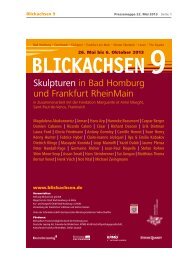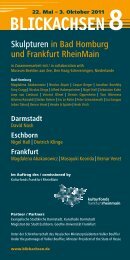Edition Scheffel - Blickachsen
Edition Scheffel - Blickachsen
Edition Scheffel - Blickachsen
Erfolgreiche ePaper selbst erstellen
Machen Sie aus Ihren PDF Publikationen ein blätterbares Flipbook mit unserer einzigartigen Google optimierten e-Paper Software.
of the city hall of Dallas, USA (no. 6, 1977) and version no. 7 that is here to be seen (1979/80). The prism-like pair made<br />
from polyester and tinted bright white are connected by a chain and a pole under water. Like “mother and child“ the<br />
two are floating on the surface of the lake with asymmetrical proportions and concave backs. The underwater pole provides<br />
a static distance so that the volumes will not touch each other even with stronger winds, but revolve around each<br />
other like satellites. The floating, brilliantly polished texture of the bodies is enhanced by their reflection on the surface<br />
of the water that doubles their shape and replenishes the bright white with the shining green and blue of nature.<br />
Jaume Plensa, Amativite/Love Urge, 2000, steel, 275 x 177 x 60 cm, location No. 16<br />
If you turn from the middle of the square called “Schmuckplatz“ downhill towards the Kurpark, you will come<br />
across a cage-like, oversized case under the shade of a willowy tree. It is not a transparent cabine that can be entered,<br />
as was the case in “<strong>Blickachsen</strong> 2/Axes of View 2”, (“Vier Möglichkeiten/Four Possibilities”), which provokes an associative-intellectual<br />
reaction” (Uwe Rüth). In this previous work, the expressions were engraved above the doors, with<br />
the choice to enter under that portent. It referred to the juice of life and the sense of taste, emotion and the behaviour<br />
of consumption.<br />
This new work deals with a porous, narrow steel box, which is patterned by a grating on the front and backsides<br />
of it in equally sized squares (24 fields per side). On each of the points intersecting points, linguistically over-stylised<br />
French expressions are engraved in the horizontal rods (15 per side), which could well stem from a textbook on psychological<br />
behaviour. The words on the front and back exactly correspond to each other. They result in the syntax of<br />
pairs of expressions such as “Philogeniture” (love of children) and “Configuration” (design), “Vénération” (respect) and<br />
“Calcul” (calculation). There is no obvious connection between the words on the front and the back or indeed between<br />
neighbouring expressions, but such consecrated words that are more intensive as any everyday language appeal to<br />
memory and longevity.<br />
“Just like the on the gable of the monuments or on a gravestone, the inscription raises the claim to have the<br />
final say” (Daniel Abadie). Each of the contradictory expression couplings, leadings to a “Babylonic” confusion of<br />
expressions, which only then obviously arises, when reason is replaced by feelings and love (Amativite).<br />
The visitor who enters the gardens longing for beauty and quiet, distance and light, is thus thrust unsuspectingly<br />
into an uncomfortable position. The unshakeable object of Plensa’s presents, instead, the “cage” of feelings.<br />
Despite its openness, it is similar to a “sell in a monastery” (according to Lorand Hegyi) or perhaps even more so, a prison,<br />
in which people who are governed by urges and desires are delivered their own ideas, imaginings, fictions and<br />
memories.<br />
George Rickey, Six Triangles, Hexagon V, 1979, polished high-grade steel, 63 x 174 x 174 cm, location no. 17<br />
“Six Triangles, Hexagon V“ (1979) is one of George Rickey’s few sculptures at ground level. The kinetic scientist<br />
Rickey, who lets motion take its course, freely defines this unusual solution as “maybe capricious variation with a<br />
simple basic shape, similar to four- and five-leaf flowers that obey their intrinsic geometrical rules. The wind will move<br />
their petals but will not change them except for turning them into the medium of a poetic message“ – the high-grade<br />
steel sculpture moved by the wind as expression of an artistic, poetical abstraction. The proximity to nature inspired<br />
the multiple artwork “Twenty nine squares“ of 1986 is obvious: twenty nine metal chips equal the leaves of a tree or<br />
shrub.<br />
“Six Triangles, Hexagon V“ that has a kind of precursor in the series around the “nimble squares“ of 1969, is<br />
based on a rhythmically staggering pattern of triangular surfaces each of which is inclined toward the middle, their<br />
short poles being attached to their undersurface and welded to a hexagonal frame. The triangles are arranged in a radial<br />
pattern not touching their respective neighbour. In the (hexagonal) inner or outer outline of their semicircular diameter<br />
they do not fuse into a ring either or even reach the same height. This way, the free standing of each basic shape<br />
and the weight of each triangle remain visible. At the same time, the symmetry of three triangles on each side facing<br />
118<br />
each other in complete balance gives an impression of tranquility, corresponding to the inhaling and exhaling of an<br />
organic body. Even when stationary, the triangles' funnel-like inclination towards the middle hints at a soft rhythm of<br />
movement, as if they would open and close in harmony like the petals of a flower. Besides the association “flower“, the<br />
work may also be seen as kind of a bowl or vessel. Here an ever vanishing content has to be refilled again and again<br />
with scooping gestures. The principle of life is congruent with the desire for fertility.<br />
These characteristics representing “living water“ are emphasized by its actual location within the entrance hall<br />
of the Kaiser-Wilhelms-Bad: The protective shell of the neo-classical architecture grants the healing and inner fulfillment<br />
supported by the house gods Hygieia and Asklepios.<br />
Ulrich Rückriem, untitled, 1986, Swedish granite (diabas), cracked and cut, ca. 220 x 115 x 95 cm,<br />
location no. 18<br />
1. Concept<br />
I seek the balance of matter and working method,<br />
form, size and location.<br />
The working methods are supposed to be visible.<br />
Individual decisions are supposed to represent<br />
general experience.<br />
2. The Themes<br />
a) A stone block is split up<br />
and joined back together into<br />
its original shape.<br />
b) Unhewn blocks will be worked with<br />
different methods<br />
to bring out their intrinsic geometrical shapes.<br />
c) Stone blocks in several pieces<br />
will be joined together<br />
by different working methods.<br />
The three themes have been combined since 1979. They<br />
may vary in singular works,<br />
double works, in groups and in series.<br />
3. The Material<br />
Granite is volcanic rock.<br />
The raw surfaces are brownish red,<br />
the cracked and carved surfaces show light greyish<br />
blue colours, the polished surfaces are of a dark greyish<br />
blue reflecting the light and showing the inner structure<br />
of the rock. The material is not supposed to be pretty in<br />
order not to distract the observer from the shape.<br />
4. The Shape<br />
The selected shapes of raw rocks of different quarries<br />
are supposed to be approximately geometrical.<br />
The forms worked out by different methods are<br />
geometrical shapes:<br />
the singular cube,<br />
the singular pillar,<br />
119<br />
the flat platform,<br />
the crust<br />
as a relief shape on a wall,<br />
the natural wedge,<br />
unhewn blocks with the outline of<br />
a four-sided figure,<br />
trapezoid or rhomboid.<br />
5. The Measure<br />
The measure of height, width and length<br />
corresponds to the measure<br />
of man,<br />
inner rooms,<br />
architecture,<br />
landscape.<br />
The measurements have an<br />
inner logic amongst them.<br />
6. The Techniques<br />
The raw material is blasted out of with dynamite.<br />
The block will be cracked down to<br />
a certain size with drillings and iron wedges.<br />
Cracking is processed<br />
without loss of material.<br />
The working object will be cut<br />
with a rope or circular saw,<br />
then partly polished,<br />
both by loss of material.<br />
I do not have my own studio.<br />
Experts of the respective quarry and sawmill will<br />
execute my works without hardly any manual work.<br />
For the workings of the rock common<br />
industrial processing techniques are used.<br />
from: Katalog der documenta 8, Kassel 1987,<br />
©Ulrich Rückriem.






